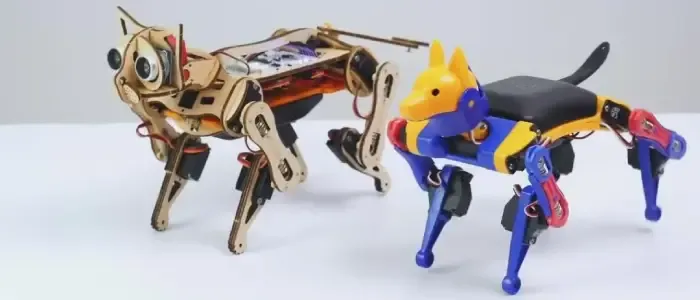
How to Fix Common Issues with Your Mechanical Dog?
Mechanical dogs can sometimes have issues that are a bit frustrating, but don’t worry, most problems have simple fixes. If your dog isn’t walking straight, double-check its position on a flat surface and recalibrate through the app. For unresponsive legs, identify any faulty servos that might need replacing or check those wheels if they’re falling off. Responsiveness issues could be solved by adjusting voice commands in the app settings. If charging is tricky, try using the direct port instead of the docking station.
1. Common Calibration Problems and Solutions
Calibration issues can often lead to frustrating experiences with your mechanical dog. Start by ensuring your robot dog is placed on a level surface when you initiate the calibration process. This foundational step helps in achieving accurate adjustments. Before recalibrating, check for any physical obstructions that could hinder movement, and make sure to clear them out. Use the app to access the calibration settings, carefully following the on-screen instructions to adjust posture. If your dog continues to misbehave after these steps, consider resetting it to factory settings and trying the calibration again.
It’s also wise to regularly check for updates in the app, as these updates could enhance calibration features. Additionally, inspect the robot for any loose screws or parts that might affect its balance during movement. Confirm that the batteries are fully charged, as low power can significantly impact calibration success. Be mindful of environmental factors, too; nearby electronic devices may interfere with sensors, complicating the calibration process.
After recalibrating, take a moment to observe the robot for a few minutes. This observation can help confirm whether it’s functioning correctly before returning to regular use. Keeping a log of your calibration attempts and their outcomes can be beneficial. This documentation allows you to identify patterns or recurring issues, enabling more effective troubleshooting in the future.
2. How to Replace a Faulty Servo?
If you find that your mechanical dog isn’t moving a leg or responding as it should, the servo is likely the culprit. Start by pinpointing the specific servo that’s malfunctioning. Watch for any movement or lack thereof, which can guide you to the knee or hip servo, for example. Before diving into the fix, gather your tools: a screwdriver, a replacement servo, and wire cutters.
Next, carefully remove the back cover of the robot. Take your time to avoid damaging any internal components. As you do this, it’s wise to document the wiring connections of the faulty servo. This will help you ensure that the new one is installed correctly. If you have the robot’s manual, consult it for the servo ID needed for the replacement.
Once you have the new servo ready, connect it by firmly attaching all wires in their correct places. After everything is connected, securely put the back cover back on. Make sure it clicks into place without any gaps. Finally, perform a functionality check. This is important to verify that the new servo operates as expected. If the problem persists, double-check the compatibility of the replacement servo with your model. If all else fails, don’t hesitate to reach out to customer support for assistance.
3. Fixing Wheel and Movement Issues
To keep your mechanical dog’s wheels in top shape, regular inspection is key. Check for any signs of wear and tear, as catching these issues early can save you a lot of hassle later. Ensure that the wheels are aligned correctly on their pegs and can rotate freely; a misalignment could cause dragging or uneven movement. If you find wheels that pop off too easily, a dab of glue can help temporarily secure them until you can replace them.
Dirt or debris can be sneaky culprits when it comes to movement problems. Make it a habit to clean out any gunk caught in the wheels or axles, as this can significantly improve performance. Uniformity is also important; confirm that all wheels are of the same model to maintain consistent movement. If a wheel is broken beyond repair, consider replacing the entire set for balanced performance.
After you’ve made repairs, always test your mechanical dog to ensure it moves smoothly and responsively. If it tends to tip over while moving, you may need to adjust its weight distribution. Finally, don’t forget to check for firmware updates, as these can sometimes rectify known wheel issues, enhancing your dog’s overall functionality. Keeping a toolkit handy for quick fixes can make all the difference when it comes to maintaining your robotic companion.
4. Troubleshooting Response Issues
If your mechanical dog isn’t responding as expected, start by ensuring the voice command feature is enabled in the app settings. Sometimes, the issue can be as simple as the distance between you and the robot; if you’re too far away from its microphone, it might not hear you. Try using different tones and volumes when giving commands, as this can impact how well the robot responds. If it’s still unresponsive, check for any obstructions near the microphone that could be blocking sound.
Additionally, recalibrating the voice recognition settings through the app can help improve sensitivity to various input styles. If you suspect environmental noise might be interfering, try to give commands in a quieter setting. Testing the response with different users can also reveal if the issue is user-specific. Lastly, ensure the robot’s software is up to date, as updates often enhance voice command capabilities. If problems persist, consulting user forums can provide insights from other owners who faced similar issues.
5. Resolving Charging Problems
To fix charging issues with your mechanical dog, start by ensuring that the docking station is plugged in and working correctly. If the robot isn’t charging, check the charging contacts on both the robot and the docking station for any dirt or corrosion; clean them if needed. It’s also wise to try a different power outlet to rule out any problems with the source. If charging still fails, connect the robot directly to its charging port to see if the issue lies with the docking station.
Regularly monitoring the battery level is important, as completely depleting it can hinder charging. Always use the original charging cable and docking station, as third-party chargers may not be compatible. Inspect the battery for signs of damage or swelling; if you notice any, you may need to replace it. If all else fails, try resetting the robot and attempting to charge it again. Ensure there are no obstacles in the charging area that could prevent proper docking. If issues persist, don’t hesitate to contact the manufacturer for assistance.
- Confirm that the docking station is plugged in and functioning properly before placing the robot on it.
- Examine the charging contacts on both the robot and the docking station for dirt or corrosion and clean them if necessary.
- Try using a different power outlet to rule out issues with the electrical source.
- If the robot won’t charge, test charging via the direct port to see if it’s a docking issue.
- Check the battery level regularly to ensure it is not completely depleted, which can affect charging.
- Use the original charging cable and docking station for best results; third-party chargers may not be compatible.
- Inspect the battery for any signs of damage or swelling, which may require replacement.
- Reset the robot and try charging again to see if that resolves the issue.
- Keep the charging area clear of obstacles that might prevent proper docking.
- If charging issues persist, consider reaching out to the manufacturer for further assistance.
6. Solutions for Stuck Legs
If your mechanical dog’s legs are stuck, start by checking the leg joints for any visible obstructions like dirt or debris. Sometimes, a simple cleaning can free them up. Try manually moving the legs; this can help you determine if the issue is mechanical or electrical. Inspect the connections of the servos to make sure they are secure. If you notice any wear, consider lubricating the joints or even replacing them. Another useful step is to recalibrate the robot to see if it resolves the movement issue. Position the robot in different areas to check if the surface impacts its ability to move. If the legs remain stuck, gently wiggle them to release any tension without causing damage. If they still don’t respond, it might be time to replace the servos. Also, check for any software updates that could fix leg movement problems. Keeping a log of any changes you make can be helpful for troubleshooting similar issues in the future.
7. Smart Watch Control Issues
If your Smart Watch isn’t connecting to your mechanical dog, start by checking the Bluetooth connection. Make sure both devices are paired and within range. Next, ensure that you have the latest version of the app installed on your Smart Watch, as updates often fix compatibility issues. Battery levels can also be a culprit; check that both your Smart Watch and the robot dog have sufficient power.
Sometimes, a simple restart can resolve glitches. Power down both devices, wait a moment, and then power them back up. Once they’re on, check the app settings to confirm that your Smart Watch is designated as a control device for your robot dog.
Testing commands in a quiet environment can help determine if background noise is affecting responsiveness. If you suspect there’s a firmware issue, look for updates that may enhance the Smart Watch’s performance with your robot dog.
If problems continue, consider resetting your Smart Watch and reconnecting it to the robot. Engaging with online communities can also be beneficial; you might find others who have faced similar issues and can share their solutions.
8. Specific Insights for Robot Dog
To keep your robot dog in top shape, start by checking the app for any specific calibration settings that cater to its unique features. If you notice that the posture seems off, don’t hesitate to recalibrate it by closely following the in-app instructions. It’s crucial to ensure the sensors are clean and free from obstructions, as this can significantly impact movement and responsiveness. Regularly look for software updates that might enhance performance or resolve known issues with your model. For troubleshooting, the user manual is a valuable resource that provides model-specific tips. Testing the robot on various surfaces can also reveal how it behaves, as certain terrains may cause unexpected issues. Keep an eye on the battery life, too; low power can lead to sluggish movements and unresponsiveness. If you notice any unusual behaviors, recording them can help identify patterns or recurring problems. Engaging with community forums can also be beneficial, as sharing experiences often leads to discovering effective solutions from other users. If all else fails, don’t hesitate to reach out to the manufacturer for assistance with specific parts or support related to your model.
9. Tips for WowWee CHiP Robot Dog
To keep your WowWee CHiP Robot Dog running smoothly, regular calibration is key. This improves movement and responsiveness, making playtime more enjoyable. Make sure to clean the wheels often; dirt can build up and hinder movement, leading to frustration. Take some time to familiarize yourself with the app’s features; it allows for optimized performance and better control over your robot dog. Don’t forget to check for updates for both the app and the robot to ensure you’re using the latest software, which can fix bugs and improve functionality.
Observe how your CHiP performs in different environments. This can help you identify potential issues and understand its limitations. Following the manufacturer’s maintenance guidelines is essential for optimal care, so keep those handy. It might also be wise to purchase spare parts like wheels or servos in advance; being prepared can save you a lot of hassle later on. Engaging with other WowWee CHiP users can provide valuable insights and tips, as sharing experiences can lead to quicker solutions.
Regularly test all features of your robot dog to catch any problems early. Documenting any repairs or maintenance can help you track your robot’s health over time, making it easier to identify recurring issues. By following these tips, you’ll ensure your WowWee CHiP stays in great shape and continues to be a fun companion.
10. Additional Resources for Repairs
When tackling repairs for your mechanical dog, there are several valuable resources to consider. Start by searching for video tutorials on platforms like YouTube, which can provide detailed, step-by-step guides tailored to your specific model. Joining online community forums or social media groups dedicated to robotic pets can also be beneficial, as these spaces often have shared experiences and solutions from other owners.
Don’t overlook the manufacturer’s website, where you can find FAQs and troubleshooting resources specific to your model. Keeping a repair log might also help; tracking issues and their solutions over time can streamline future fixes. Look for downloadable manuals or guides that offer detailed maintenance instructions.
If you prefer hands-on learning, attending local meetups or workshops focused on robotic pets can be an excellent way to learn repair techniques. Additionally, reading reviews on tools and parts can ensure you’re using the best options for your repairs. For extra tips, consult tech blogs or articles that specialize in robotic pets. If you encounter complicated issues or need assistance with parts replacement, engaging with customer support can provide personalized help. Lastly, if DIY solutions don’t resolve the problems, exploring local repair shops that specialize in electronics can be a wise choice.
Frequently Asked Questions
1. What should I do if my mechanical dog won’t turn on?
First, check if the batteries are installed correctly or if they’re drained. If everything seems fine, try resetting the dog by turning it off and on again.
2. How can I fix my mechanical dog’s movements if they’re stuck?
Look for any obstructions around its joints or wheels. Gently remove any dirt or debris, and try lubricating the moving parts with a small amount of oil if needed.
3. Why does my mechanical dog make strange noises?
Sounds could be a sign of something loose inside. Inspect it for any loose screws or parts. Tightening them might help reduce the noise.
4. What if my mechanical dog isn’t responding to commands?
Check if it’s in the right mode for listening to commands. Also, make sure its sensors aren’t blocked and that it’s not too far from the remote control.
5. How do I troubleshoot my mechanical dog’s battery issues?
Examine the batteries for corrosion or damage. Replace them with fresh ones, and ensure they’re installed properly.
TL;DR Learn how to troubleshoot and fix common issues with your mechanical dog, from calibration and servo replacement to charging problems and smart watch functionality. Key solutions include recalibrating for straight walking, replacing faulty parts, ensuring proper wheel attachment for WowWee CHiP, and updating app settings for better responsiveness.



